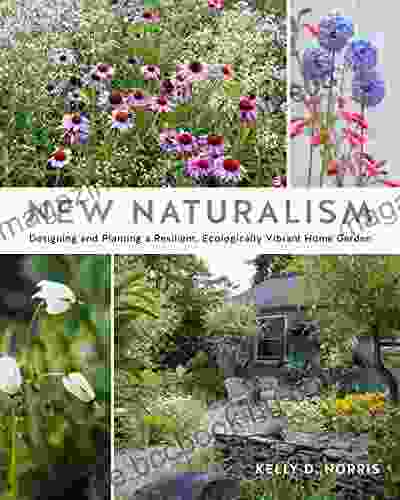Designing and Planting Resilient and Ecologically Vibrant Home Gardens

In today's rapidly changing world, it's more important than ever to have a resilient and sustainable food source. One way to do this is to create a home garden. But not all gardens are created equal. Some gardens are designed to be beautiful, while others are designed to be productive. And still, others are designed to be both beautiful and productive.
4.6 out of 5
| Language | : | English |
| File size | : | 53283 KB |
| Text-to-Speech | : | Enabled |
| Screen Reader | : | Supported |
| Enhanced typesetting | : | Enabled |
| X-Ray | : | Enabled |
| Print length | : | 423 pages |
In this article, we'll discuss how to design and plant a resilient and ecologically vibrant home garden. We'll cover everything from plant selection to garden design to soil health. By following these tips, you can create a garden that will provide you with fresh, healthy food for years to come.
Plant Selection
The first step in creating a resilient garden is to choose the right plants. When selecting plants, it's important to consider the following factors:
- Climate: Choose plants that are well-suited to your local climate. This means considering factors such as temperature, rainfall, and sunlight.
- Soil conditions: Different plants have different soil requirements. Make sure to choose plants that are suited to the soil conditions in your garden.
- Water availability: Consider how much water you are willing and able to provide for your garden. Choose plants that are drought-tolerant or that can tolerate periods of dry weather.
- Pest and disease resistance: Choose plants that are resistant to pests and diseases common in your area.
- Nutritional value: Choose plants that are rich in nutrients. This will help you to get the most out of your garden.
Once you've considered these factors, you can start to select plants for your garden. A good place to start is by visiting your local nursery or garden center. They can help you choose plants that are right for your area and your needs.
Garden Design
The next step is to design your garden. When designing your garden, it's important to consider the following:
- Sunlight: Most plants need at least six hours of sunlight per day. Make sure to place your plants in areas where they will receive adequate sunlight.
- Water: Plants need water to grow. Make sure to design your garden in a way that allows you to easily water your plants.
- Access: You should be able to easily access all areas of your garden. This will make it easier to plant, weed, and harvest your crops.
- Companion planting: Companion planting is a technique of planting different types of plants together to benefit each other. For example, planting tomatoes and basil together can help to improve the flavor of both plants.
Once you've considered these factors, you can start to design your garden. There are many different ways to design a garden, so don't be afraid to experiment. You can use raised beds, containers, or even a traditional in-ground garden.
Soil Health
The health of your soil is essential for a successful garden. Healthy soil is rich in nutrients and organic matter. It also has good drainage and aeration. To improve the health of your soil, you can do the following:
- Add compost to your soil: Compost is a great way to add nutrients and organic matter to your soil. You can make your own compost or Free Download it from a garden center.
- Cover your soil with mulch: Mulch is a layer of material, such as straw, hay, or leaves, that is spread over the soil. Mulch helps to retain moisture, suppress weeds, and regulate soil temperature.
- Practice crop rotation: Crop rotation is a technique of planting different types of plants in the same area over time. This helps to improve soil health and reduce the risk of pests and diseases.
By following these tips, you can improve the health of your soil and create a more productive garden.
Creating a resilient and ecologically vibrant home garden is a rewarding experience. By following the tips in this article, you can create a garden that will provide you with fresh, healthy food for years to come.
Remember, a resilient garden is more than just a place to grow food. It's also a place to connect with nature, learn about the environment, and inspire others. So get started today and create a garden that you can be proud of.
4.6 out of 5
| Language | : | English |
| File size | : | 53283 KB |
| Text-to-Speech | : | Enabled |
| Screen Reader | : | Supported |
| Enhanced typesetting | : | Enabled |
| X-Ray | : | Enabled |
| Print length | : | 423 pages |
Do you want to contribute by writing guest posts on this blog?
Please contact us and send us a resume of previous articles that you have written.
 Book
Book Novel
Novel Page
Page Chapter
Chapter Text
Text Story
Story Genre
Genre Reader
Reader Library
Library Paperback
Paperback E-book
E-book Magazine
Magazine Newspaper
Newspaper Paragraph
Paragraph Sentence
Sentence Bookmark
Bookmark Shelf
Shelf Glossary
Glossary Bibliography
Bibliography Foreword
Foreword Preface
Preface Synopsis
Synopsis Annotation
Annotation Footnote
Footnote Manuscript
Manuscript Scroll
Scroll Codex
Codex Tome
Tome Bestseller
Bestseller Classics
Classics Library card
Library card Narrative
Narrative Biography
Biography Autobiography
Autobiography Memoir
Memoir Reference
Reference Encyclopedia
Encyclopedia Kellian
Kellian Robert De La Sizeranne
Robert De La Sizeranne Sharon Chriscoe
Sharon Chriscoe Kathleen M Eisenhardt
Kathleen M Eisenhardt Thomas E Johnson
Thomas E Johnson Katherine Eban
Katherine Eban Weike Wang
Weike Wang Martin J Smith
Martin J Smith Katlin Sarantou
Katlin Sarantou R M Arcejaeger
R M Arcejaeger Katherine Ellison
Katherine Ellison Melanie Dickerson
Melanie Dickerson Paul Krugman
Paul Krugman Kenneth Oppel
Kenneth Oppel Sallust
Sallust Katie Kitamura
Katie Kitamura Kathy Steinemann
Kathy Steinemann Keith Hamilton Cobb
Keith Hamilton Cobb Trilokesh Dayananda
Trilokesh Dayananda Robert M Sapolsky
Robert M Sapolsky
Light bulbAdvertise smarter! Our strategic ad space ensures maximum exposure. Reserve your spot today!

 Kurt VonnegutDive into the Vibrant World of Vegan and Vegetarian Asian Delights with "Best...
Kurt VonnegutDive into the Vibrant World of Vegan and Vegetarian Asian Delights with "Best...
 Arthur MasonBig Nate Stays Classy Two-In-One: The Ultimate Comic Odyssey of a Sixth-Grade...
Arthur MasonBig Nate Stays Classy Two-In-One: The Ultimate Comic Odyssey of a Sixth-Grade... Dean ButlerFollow ·12.1k
Dean ButlerFollow ·12.1k Matt ReedFollow ·12k
Matt ReedFollow ·12k Shawn ReedFollow ·12.1k
Shawn ReedFollow ·12.1k Chinua AchebeFollow ·15.2k
Chinua AchebeFollow ·15.2k Samuel BeckettFollow ·4.7k
Samuel BeckettFollow ·4.7k Ernest HemingwayFollow ·10.3k
Ernest HemingwayFollow ·10.3k Elton HayesFollow ·15.7k
Elton HayesFollow ·15.7k Craig BlairFollow ·12.6k
Craig BlairFollow ·12.6k

 Joshua Reed
Joshua ReedUnveiling the Profound Essence of Taekwondo: Spirit and...
Taekwondo, an ancient...

 Clarence Brooks
Clarence BrooksUnveiling Clarity: The Common Sense Guide to Everyday...
In the labyrinthine world of legal...

 Anthony Wells
Anthony WellsBless Me, Ultima: A Literary Odyssey into the Heart of...
In the tapestry of American literature,...

 Alexandre Dumas
Alexandre DumasPioneer Life Or Thirty Years A Hunter - A Captivating...
Discover the Raw and...

 Samuel Beckett
Samuel BeckettThe Mike Fisher Story: An Inspiring Tale of Faith,...
Prepare to be...
4.6 out of 5
| Language | : | English |
| File size | : | 53283 KB |
| Text-to-Speech | : | Enabled |
| Screen Reader | : | Supported |
| Enhanced typesetting | : | Enabled |
| X-Ray | : | Enabled |
| Print length | : | 423 pages |










